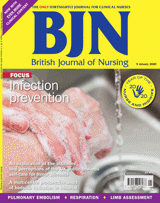References
The diagnosis and management of pulmonary embolism
Abstract
Pulmonary embolism (PE) is a condition characterised by an obstruction of the pulmonary arterial system by one or more emboli. Advanced clinical practitioners are often faced with ruling out a diagnosis of PE in patients with non-specific symptoms such as dyspnoea and pleuritic chest pain, which can be fairly mild and therefore a diagnosis of PE easily missed. PEs can be a challenge to diagnose, especially in elderly people, since it can be difficult to differentiate their symptoms from other less serious illnesses. Widely used scoring tools are helpful to calculate a patient's probability of having a PE. The Wells score is the most widely used pre-test clinical probability indicator of PE used in the UK, which scores the patient's probability of having a PE based on their risk factors. The D-dimer test is a relatively simple investigation to rule out venous thromboembolism (VTE) but can be raised for various reasons other than PE. Computed tomography pulmonary angiography (CTPA) is regarded as the gold standard imaging modality for investigation of acute PE but ventilation-perfusion (VQ) scans can be used as an alternative imaging technique for diagnosing PE in those where CTPA is contraindicated. Thrombolysis is underused in clinical practice due to the fear of adverse bleeding events. Patients without a massive or sub-massive PE are treated with anticoagulant therapy, usually commencing with subcutaneous low-molecular-weight heparin and switching over to a direct oral anticoagulant (DOAC). There has been a shift away from treatment with warfarin for the prevention and treatment of VTE over the past decade.
Pulmonary embolism (PE) is a condition characterised by an obstruction of the pulmonary arterial system by one or more emboli (National Institute of Health and Care Excellence (NICE), 2019a). In the authors' experience, patients often present with non-specific symptoms, which makes diagnosis of a PE difficult. In addition, the assessment and diagnosis of PE can vary across specialties and clinicians. In this discussion the authors will critically analyse and discuss the evidence around the diagnosis and management of PE.
Advanced clinical practitioners (ACPs) are often faced with ruling out a diagnosis of PE in patients with non-specific symptoms such as dyspnoea and pleuritic chest pain, which can be fairly mild, and therefore a diagnosis of PE easily missed (Geersing et al, 2012). In addition, patients may also present with symptoms such as haemoptysis, fever and tachycardia (European Lung Foundation, 2019). Pulmonary embolism can be a challenge to diagnose, especially in elderly people, since it can be difficult to differentiate their symptoms from other less serious illnesses (Ma et al, 2017). These may include upper or lower viral respiratory tract infection, undiagnosed or exacerbation of chronic obstructive pulmonary disease (COPD) and bronchiectasis.
Register now to continue reading
Thank you for visiting British Journal of Nursing and reading some of our peer-reviewed resources for nurses. To read more, please register today. You’ll enjoy the following great benefits:
What's included
-
Limited access to clinical or professional articles
-
Unlimited access to the latest news, blogs and video content

